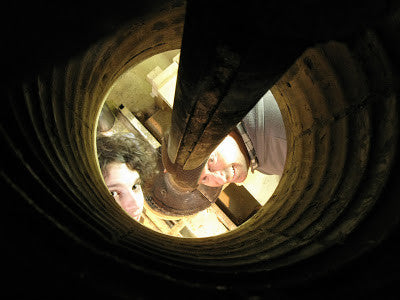
Seven years after it was established in 1977, demand for Morris and James pottery far exceeded its ability to deliver. Everything was produced by hand which was fine for the smaller pots, but not so good for the big ones, which were most in demand. At that time virtually no one else in the country was supplying decent sized pots.
The most physically challenging part of throwing a large pot is centering the ball of clay on the rotating wheel head and then opening it up to form the pot. For particularly big vessels this initial ball can weigh upwards of 25 kilograms, which requires considerable skill, strength and sustained effort to control. The physical demands put huge strain on the potters, limiting how much they could safely make.
Various innovations were tried, including the construction of a giant ‘jolley’, a scaled up version of a common piece of commercial pottery equipment. In simple terms, clay was forced into a spinning mould using a shaped steel tool to form a pot. Comparatively straightforward on a small scale, the larger version was a truly scary machine! The pot had to be constructed in stages, with clay packed around the inside of the mould as the pot grew, until a cylinder 1 meter high and 500 mm in diameter had been formed. This was then removed from the mould and transferred to a throwing wheel where it would be turned into a pot. Ingenious as it was, this solution turned out to be very slow and terribly inefficient with as many as three quarters of the pots being rejects.
The solution to this problem was eventually found in the form of a gigantic overhead extruder, purchased from a firm in Perth, Western Australia. This massive piece of industrial machinery, originally intended to make sewer pipes, was imported and over a number of years installed and modified to suit
our purposes.
Clay is fed into the machine and forced down through a die to create cylinders of clay; as each is formed it is also attached to a disc of clay that becomes the base. We have dies of various sizes, and can extrude tubes of different lengths, which then become the starting point for our potters who transform them into the various styles of pot.



As you can imagine the force required to squeeze the clay through the die is enormous; this combined with the abrasive nature of the clay takes its toll on the inside of the machine. Inevitably the metal parts become worn and the machine less efficient, so for the second time since it was installed we have this week had to strip it down and remove the auger, the screw that drives the clay down through the die head.


It is remarkable how the clay has forced its way through tiny cracks, eventually opening them up into gaps several centimeters wide. The whole lot has been sent away to a specialist engineering shop where a hard chrome alloy has been welded onto the exposed surfaces to toughen and extend its life for a few more years. The next time we strip it down will be to reline the cylinder in which the screw sits…but hopefully not too soon!
- Nick C

